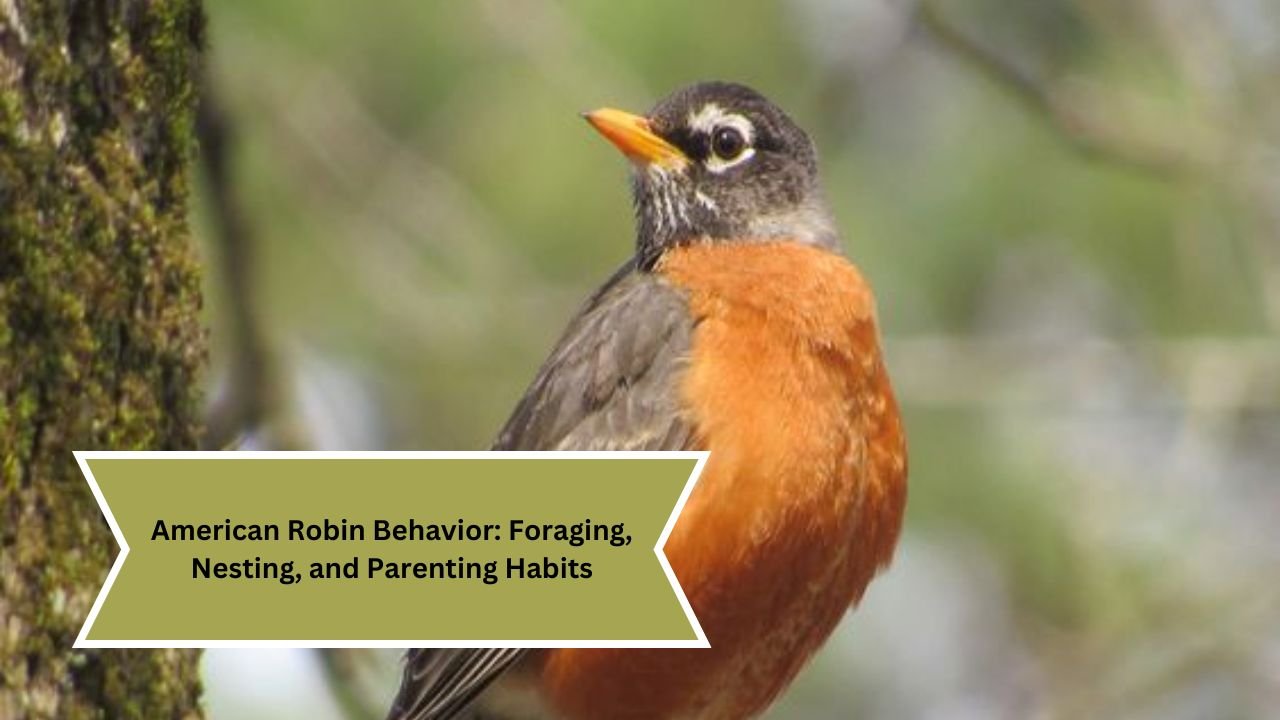The American robin (Turdus migratorius) is one of the most recognizable birds in North America, often heralding the arrival of spring with its cheerful song and bright orange belly. Known for their striking appearance and melodious calls, these birds exhibit fascinating behaviors related to foraging, nesting, and parenting. This article explores the intricacies of American robin behavior, shedding light on how these birds adapt to their environment and raise their young.
Foraging Habits
American robins are highly adaptable foragers, with a diverse diet that primarily consists of insects, fruits, and berries. Their foraging behavior varies significantly depending on the season and availability of food sources.
Diet
During the spring and summer months, robins predominantly feed on insects such as earthworms, beetles, and caterpillars. This protein-rich diet is essential for their reproductive success and the development of their young. American robins are known for their unique foraging technique; they often walk slowly and deliberately across the ground, pausing frequently to listen for the faint sounds of hidden worms beneath the soil. Once they detect a potential meal, robins will use their sharp beaks to probe the ground and extract the worms.
As autumn approaches and insect populations dwindle, robins shift their focus to fruit and berries. They are particularly fond of cherries, blueberries, and various types of wild berries. This shift in diet is critical for their energy reserves as they prepare for migration. In urban areas, robins can often be seen foraging in gardens and parks, taking advantage of cultivated fruits and berries.
Foraging Behavior
Robins are known for their keen sense of sight, which plays a vital role in their foraging success. They often forage alone or in small groups, but they also join larger flocks during migration or when searching for abundant food sources. During foraging, robins exhibit a characteristic behavior of tilting their heads to listen for movement underground. This behavior enhances their ability to locate hidden prey.
In addition to their auditory skills, robins also use visual cues to identify ripe fruits. They often perch on branches, surveying their surroundings for potential food sources. When they spot a ripe berry, they will fly down to consume it, sometimes taking off immediately if they sense potential threats nearby.
Nesting Habits
Nesting is a crucial aspect of American robin behavior, and these birds are known for their distinctive nests. Typically, robins will build their nests in trees, shrubs, or even on ledges of buildings, showcasing their adaptability to different environments.
Nest Construction
The construction of a robin’s nest involves a meticulous process. Female robins are primarily responsible for building the nest, which consists of various materials such as twigs, grass, mud, and leaves. The female will gather these materials from her surroundings, often selecting soft, pliable grasses and mud to create a sturdy structure.
The nest is usually built in a cup shape, providing a secure environment for the eggs and chicks. The inner lining is often made of finer materials, such as feathers or soft plant fibers, ensuring comfort for the young. Once the nest is complete, the female will lay a clutch of three to five eggs, which are typically blue in color, giving rise to their nickname, “bluebirds.”
Incubation and Hatching
After laying the eggs, the female will incubate them for about 12 to 14 days. During this period, the male robin plays a supportive role, bringing food to the female and keeping a watchful eye on the nest. The female will leave the nest only briefly to feed, ensuring that the eggs are kept warm.
Once the eggs hatch, the chicks are altricial, meaning they are born helpless and dependent on their parents for survival. The young robins are covered in down feathers and have their eyes closed at birth. Their rapid development is aided by the attentive care of their parents, who work tirelessly to feed and protect their young.
Parenting Behavior
The parenting habits of American robins are exemplary, showcasing their commitment to the survival of their offspring. Both parents play an essential role in the upbringing of their young.
Feeding the Young
After hatching, the male and female robins share the responsibility of feeding their chicks. They will hunt for insects and worms, often bringing food back to the nest in their beaks. When the parents arrive at the nest, the chicks respond with loud begging calls, signaling their hunger. The adults will regurgitate the food to the chicks, providing them with the necessary nutrients to grow quickly.
Robins have a remarkable ability to gauge the feeding needs of their young. As the chicks grow and become more active, the parents adjust their feeding frequency, ensuring that each chick receives enough food to thrive. This dynamic feeding strategy is crucial for the successful development of the chicks, enabling them to fledge and eventually leave the nest.
Fledging and Independence
After approximately 14 to 16 days of intensive care, the chicks are ready to leave the nest, a stage known as fledging. At this point, the young robins have developed their feathers and can start flying. However, their independence does not mean the end of parental involvement; the adults continue to care for their fledglings for several weeks, teaching them how to forage and navigate their surroundings.
During this time, the fledglings may be seen hopping around nearby, practicing their flying skills and learning to find food. The parents will encourage their young by demonstrating foraging techniques and providing food until they become fully independent.
Adaptability and Urban Living
One of the remarkable aspects of American robins is their adaptability to urban environments. These birds thrive in cities and suburban areas, where they often take advantage of ornamental trees, gardens, and parks. Their ability to adjust their nesting and foraging behaviors to urban landscapes has contributed to their status as one of the most widespread and familiar bird species in North America.
Coping with Challenges
While urban living offers new opportunities for foraging and nesting, it also presents challenges, such as traffic, pollution, and habitat loss. American robins have demonstrated resilience by modifying their nesting sites and foraging behaviors. They often build nests on rooftops, ledges, and balconies, showcasing their ingenuity in adapting to human environments.
In addition to their nesting strategies, robins also find food in urban gardens, parks, and yards. Homeowners who cultivate berry-producing plants or maintain grassy areas provide valuable resources for these birds, supporting their foraging needs.
Conclusion
The American robin is a remarkable bird known for its vibrant appearance and engaging behaviors. From their intricate foraging techniques to their diligent nesting and parenting habits, these birds exhibit a rich tapestry of behaviors that reflect their adaptability and resilience. Understanding the behavior of American robins not only enhances our appreciation for these beautiful creatures but also underscores the importance of conserving their habitats and supporting their survival in an ever-changing world. By fostering a deeper connection with nature and encouraging the presence of robins in our backyards, we can contribute to the well-being of this beloved species for generations to come.
| HOME | CLICK HERE |
| AMERICAN ROBIN | CLICK HERE |

